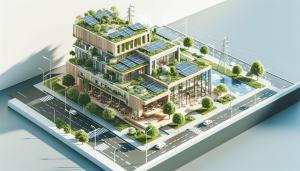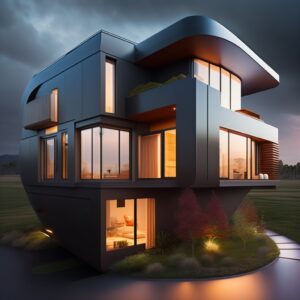In our journey to create a more sustainable world, sustainable architecture plays a crucial role in supporting the United Nations Sustainable Development Goals (UN SDGs). By incorporating eco-friendly designs and energy-efficient systems, we can significantly reduce our carbon footprint and promote the responsible use of resources. Sustainable architecture not only aims to minimize the negative environmental impact through thoughtful design and material selection but also enhances the quality of life within our communities by fostering healthier living spaces and resilient infrastructures. Collectively, these efforts align closely with several of the UN SDGs, driving us closer to achieving a balance between growth and sustainability. Have you ever wondered how sustainable architecture supports the UN Sustainable Development Goals (SDGs)? As we navigate through an era of increased global awareness about environmental and social challenges, sustainable architecture emerges as a critical player. Sustainable architecture is not simply about building greener structures; it intricately aligns with a plethora of the SDGs, advancing a more resilient and just future for all.

What is Sustainable Architecture?
Definition
At its core, sustainable architecture is a design philosophy aimed at minimizing negative environmental impacts through efficiency and moderation in the use of materials, energy, and development space. This involves the thoughtful integration of design with the natural environment while promoting human health and well-being.
Key Principles
Let’s delve into some of the key principles that underpin sustainable architecture to better understand its essence.
- Energy Efficiency: Reducing energy consumption through the use of renewable energy sources and high-performance building systems.
- Eco-friendly Materials: Utilizing materials that are sustainable, recyclable, and have a low environmental impact.
- Waste Reduction: Minimizing construction waste and promoting recycling and reuse.
- Water Conservation: Implementing systems for efficient water use and reuse.
- Healthy Environments: Enhancing indoor environmental quality by using non-toxic materials and proper ventilation.
The Connection with Sustainability
Sustainable architecture not only focuses on the ecological impact but also addresses the social and economic dimensions of sustainability. Its holistic approach makes it a potent tool for achieving the UN Sustainable Development Goals.
The UN Sustainable Development Goals (SDGs)
Overview
The UN SDGs are a collection of 17 interconnected global goals designed to achieve a better and more sustainable future by addressing major world issues such as poverty, inequality, climate change, and environmental degradation. These goals were adopted by all UN Member States in 2015 as part of the 2030 Agenda for Sustainable Development.
The List of SDGs
Below is a table summarizing the 17 SDGs:
| Goal Number | Description |
|---|---|
| 1 | No Poverty |
| 2 | Zero Hunger |
| 3 | Good Health and Well-Being |
| 4 | Quality Education |
| 5 | Gender Equality |
| 6 | Clean Water and Sanitation |
| 7 | Affordable and Clean Energy |
| 8 | Decent Work and Economic Growth |
| 9 | Industry, Innovation, and Infrastructure |
| 10 | Reduced Inequalities |
| 11 | Sustainable Cities and Communities |
| 12 | Responsible Consumption and Production |
| 13 | Climate Action |
| 14 | Life Below Water |
| 15 | Life on Land |
| 16 | Peace, Justice, and Strong Institutions |
| 17 | Partnerships for the Goals |
How Sustainable Architecture Supports Various SDGs
SDG 1: No Poverty
Sustainable architecture plays a role in poverty alleviation by creating affordable housing with lower energy and maintenance costs. Energy-efficient homes reduce utility expenses, making affordable living more attainable for low-income families.
SDG 2: Zero Hunger
Urban agriculture via sustainable architecture can help address food security. By designing buildings with green roofs and vertical gardens, we can cultivate local food production, reducing the strain on food resources.
SDG 3: Good Health and Well-being
Good health and wellbeing are significantly impacted by the built environment. Sustainable architecture promotes the use of non-toxic materials, proper ventilation, and natural lighting, all of which contribute to healthier living and working environments.
SDG 4: Quality Education
Schools designed with sustainable principles can offer better learning environments. Natural lighting and proper ventilation have been shown to improve concentration and performance, thus ensuring a higher quality of education.
SDG 5: Gender Equality
While not directly impacting gender equality, sustainable architecture encourages inclusive design practices. Buildings and spaces that are accessible to everyone, regardless of gender, contribute to a more equitable society.
SDG 6: Clean Water and Sanitation
Incorporating efficient water management systems in buildings—like rainwater harvesting and greywater recycling—promotes the conservation of clean water and the treatment of wastewater, contributing to better sanitation practices.
SDG 7: Affordable and Clean Energy
One of the most direct impacts of sustainable architecture is in the domain of clean energy. By integrating renewable energy sources like solar and wind power and focusing on energy-efficient designs, buildings can achieve significant reductions in their energy footprint.
SDG 8: Decent Work and Economic Growth
The sustainable construction industry creates jobs and stimulates economic growth by pushing for green technologies and innovative building practices. Workers are skilled in new trades that are crucial for a sustainable future.
SDG 9: Industry, Innovation, and Infrastructure
Sustainable architecture promotes innovation and resilient infrastructure by integrating cutting-edge technologies such as smart grids, IoT (Internet of Things), and advanced materials. These advancements lead to smarter and more sustainable urban development.
SDG 10: Reduced Inequalities
By focusing on inclusive design, sustainable architecture ensures that buildings are accessible to all, including people with disabilities and marginalized communities. This inclusivity helps in reducing social inequalities.
SDG 11: Sustainable Cities and Communities
This goal directly aligns with sustainable architecture. Designing buildings and communities that are inclusive, safe, resilient, and sustainable helps create better living conditions and promotes sustainable urbanization.
SDG 12: Responsible Consumption and Production
Sustainable architecture advocates for the use of materials that are recycled, renewable, and have a lower environmental impact. By encouraging responsible resource management, it supports sustainable consumption and production patterns.
SDG 13: Climate Action
Buildings are major contributors to greenhouse gas emissions. Sustainable architecture reduces these emissions through energy-efficient designs and the use of renewable energy sources. Thus, it plays a crucial role in global climate action strategies.
SDG 14: Life Below Water
While not directly related, sustainable architecture can impact marine life positively by reducing water pollution. Efficient wastewater management and stormwater runoff systems prevent contaminants from entering aquatic ecosystems.
SDG 15: Life on Land
Sustainable architecture conserves biodiversity by minimizing land disturbance and promoting the use of native landscaping. Green buildings incorporate rooftop gardens and green spaces, contributing to urban biodiversity.
SDG 16: Peace, Justice, and Strong Institutions
Sustainable architecture can enhance peace and security by designing buildings and communities that are safe and promote a sense of well-being. Accessible public spaces foster community interaction and social cohesion.
SDG 17: Partnerships for the Goals
The collaborative nature of sustainable architecture promotes partnerships across various sectors—government, private, and civil society. These partnerships are crucial for the successful implementation of sustainable building practices on a global scale.
Challenges and Solutions in Sustainable Architecture
Challenges
High Initial Costs
One of the common challenges in sustainable architecture is the high initial cost of incorporating green technologies and materials. This can be a barrier, especially in developing countries.
Lack of Awareness
There’s also a significant lack of awareness about the long-term benefits of sustainable architecture among stakeholders, which hampers its widespread adoption.
Regulatory Barriers
In many regions, existing building codes and regulations do not support or encourage sustainable practices, making it difficult to implement sustainable designs.
Solutions
Financial Incentives
Governments can offer financial incentives like tax breaks and grants to offset the initial costs of sustainable building practices, making them more accessible.
Education and Awareness
Raising awareness and providing education on the benefits and practices of sustainable architecture can drive more stakeholders to adopt these methods.
Policy and Regulation
Updating building codes and policies to support sustainable practices can remove regulatory barriers and promote the widespread adoption of sustainable architecture.

Real-World Examples of Sustainable Architecture Supporting SDGs
Bosco Verticale, Italy
Bosco Verticale (Vertical Forest) in Milan consists of two residential towers incorporating over 900 trees, 5,000 shrubs, and 11,000 floral plants. This sustainable approach creates a microhabitat that enhances urban biodiversity, contributing to SDGs 11 and 15.
The Edge, Amsterdam
The Edge is one of the most sustainable office buildings in the world. Equipped with solar panels, rainwater harvesting systems, and smart building technologies, it exemplifies the integration of SDGs 7, 9, and 13 in architectural design.
One Central Park, Australia
One Central Park in Sydney features vertical gardens and a cantilevered heliostat that directs sunlight to gardens and public spaces below. It significantly contributes to energy savings and biodiversity, addressing SDGs 7, 11, and 15.
The Future of Sustainable Architecture
Emerging Trends
Smart Buildings
The incorporation of smart technologies, IoT, and AI in buildings will enhance energy efficiency and resource management, taking sustainable architecture to new heights.
Biophilic Design
Integrating natural elements like greenery, natural lighting, and water features into architecture will promote human well-being and connect occupants with the natural environment.
Community-Centric Design
Focusing on community needs and participatory design processes will ensure that sustainable architecture not only addresses environmental issues but also fosters social equity and resilience.

Conclusion
Sustainable architecture is deeply intertwined with the UN Sustainable Development Goals, offering innovative solutions to some of the world’s most pressing challenges. By championing eco-friendly materials, energy efficiency, and inclusive design, sustainable architecture not only creates healthier environments but also promotes economic growth, social equity, and environmental stewardship.
In embracing sustainable architecture, we are not just building structures; we are constructing a future that aligns with global aspirations for peace, prosperity, and planetary health. Let’s continue to explore and implement these sustainable practices in our quest to achieve the SDGs and foster a more sustainable world for generations to come.



